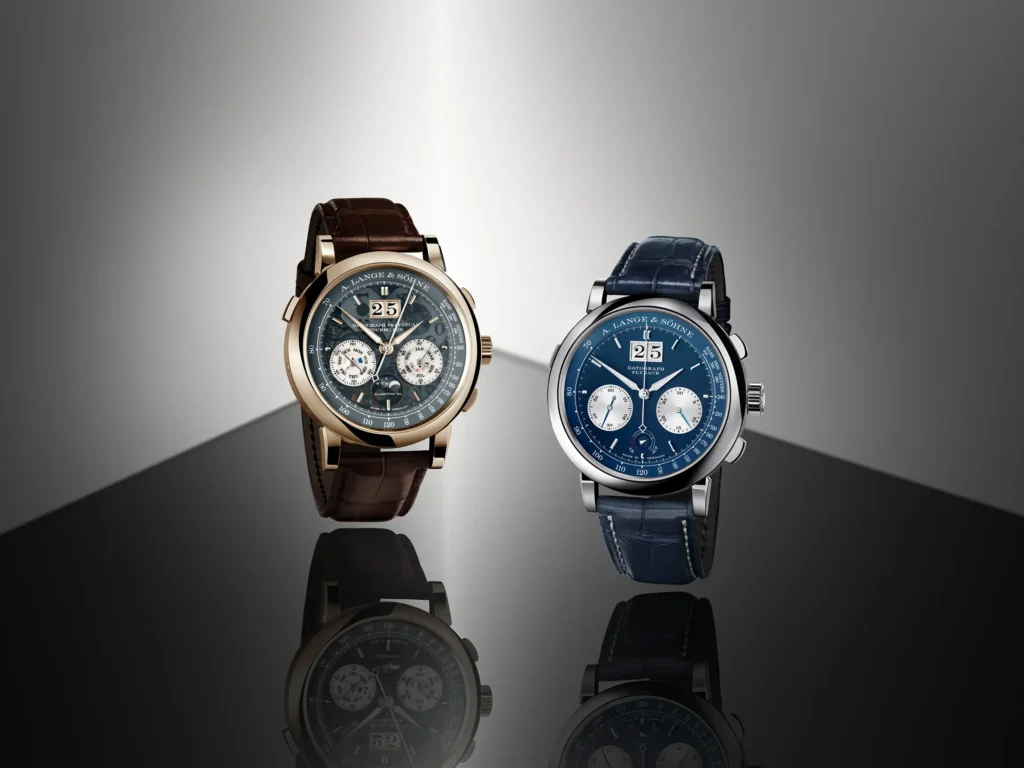This year marks 25 years since the iconic Datograph was revealed by A Lange & Sohne at the 1999 Baselworld fair alongside boothmates IWC and JLC. The watch would become a cornerstone of the brand’s rebirth, and redefine the in-house chronograph as we know it with the caliber L951.1 developed for the Datograph by Reinhard Meis, Helmut Geyer and Annegret Fleischer. To honor 25 years of the Datograph, A Lange & Sohne brought a pair of new references to Watches & Wonders this year, one a new iteration of the existing Datograph Up/Down, and another that utilizes everything in the Lange bag of tricks called the Datograph Perpetual Tourbillon Honeygold “Lumen”.

It’s worth taking a step back to fully appreciate the original Datograph 25 years later, and the impact that it’s had on the industry as a whole. There is plenty of lore around this watch, from the early ‘Meter’ dials, to its charming dimensions, and the fact that a young woman in her 20s, Annegret Fleischer, was responsible for designing the chronograph works of the movement. The Datograph was a monumental watch to be sure, but it was not the first post quartz-crisis integrated chronograph movement to be introduced; that honor goes to the Jaeger-LeCoultre Reverso retrograde chronograph released in 1996 (another amazing watch in its own right, and a story for another day).

The caliber L951.1 within the Datograph was a revelation when it was introduced (and remains so today) thanks to its depth, design, and material usage. It looked unlike anything else out there. And to provide some context, just a year prior Patek Philippe released their 5070 chronograph whose CH 27-70 hand wound caliber was built on a Lemania caliber 2310. It’s difficult to imagine these days, but this was relatively common at the time, and was not (and should not be) looked down upon. You can hear more of my thoughts on the ‘in-house’ trend in this video.

The Datograph opened the door for the development of a new breed of chronograph, the effects of which reverberate strongly to this day. The movement wasn’t the only unique aspect of the Datograph, however. The dial and case design have each made their mark in other ways. The dial in particular is held in high regard for its composition that places the center of the registers and the center of the big date apertures (inspired by the clock displayed in the Dresden Semper Opera) in triangular alignment, achieving a kind of balance rarely seen in a watch, which is allowed thanks to the design of the movement within. The watch began with the design, and the movement was created to bring it to life.

The chief designer of the watch, Reinhard Meis, actually penned a rather lovely tonneau design for the watch in the early phases of the project, but this was scrapped in favor of the round case we know and love today. The original Datograph was released in a platinum case measuring 39mm in diameter, and 12.8mm in thickness. One of the few criticisms brought against this case is the curvature leading up to the exhibition caseback, which sets the watch up slightly higher on the wrist than you might imagine, and compounds the top heavy tendency of the platinum case on a leather strap. In truth, it’s not that bad on the wrist by any stretch, and the introduction of a 1918 Chronograph alleviates any perceived issues by removing the date.

In 2012, A. Lange & Sohne introduced a new generation of the Datograph called Up/Down for its inclusion of a power reserve indication at the bottom of the dial. Not only did this display the remaining power in the mainspring barrel, but even when it would be at its most accurate within its range. This wasn’t the only change, however. The case grew to 41mm in diameter, and 13.1mm in thickness, and furthermore, the Roman numerals on the dial gave way to applied baton indexes. The result, while unquestionably beautiful, is a bit cleaner, perhaps a bit more refined, but lacks a bit of the overall character seen in the original, if you ask me. The 25th anniversary led many to believe that we might see a dial design return to its roots in some fashion, but it was not to be.

Instead, we received a new white gold reference of the Up/Down with a blue dial crafted from 925 silver. This is the first time we’ve seen such a configuration within the Datograph collection, and it works exactly as well as you might expect. The blue is similar to what we’ve seen in the Triple Split collection, also within the Saxonia family. The movement at work here is the L951.6, in the same lineage as the original, comprising 451 parts and providing 60 hours of reserve thanks to the removal of the Maltese cross on the mainspring barrel (used to limit the energy transfer below a certain torque level to ensure optimal timekeeping). The new movement also features a free-sprung balance with overcoil developed in-house. Yes, the view around the back is just as striking as it’s ever been.

The new Up/Down, as lovely as it is, was not the big draw at the Lange booth this year, however. That honor belongs to the other watch they brought, the Datograph Perpetual Tourbillon Honeygold ‘Lumen’. This watch is the culmination of a number of special features generally reserved for special editions, all rolled into one. The Datograph Perpetual Tourbillon is a special watch in its own right, bringing a perpetual calendar with moonphase complications to the standard Datograph, all without disturbing that golden balance discussed earlier. Oh, and it’s regulated by a tourbillon.

This configuration has been placed within a Honeygold case for the first time, and has been given the ‘Lumen’ treatment for good measure. This makes use of a transparent dial plate, allowing a view to the dial side mechanics at work underneath. Additionally, with the strategic placement of luminous coatings within the tachymeter, display wheels for the date and calendar complications, as well as the moon phase indication, the view afforded in low light conditions takes on an entirely new dimension. This watch is something of a greatest hits compilation of all recent Lange innovations into a single reference, and it’s an absolute powerhouse to behold. Just 50 examples will be made, each priced at $620,000.

This may not be the tribute to the history of the Datograph we were expecting at this 25th anniversary, but this is a defiant foot forward for the brand. A stake in the ground as to their intentions to move in one direction, and pursue innovation while expanding their mechanic and aesthetic DNA to a new generation. A. Lange & Sohne

















